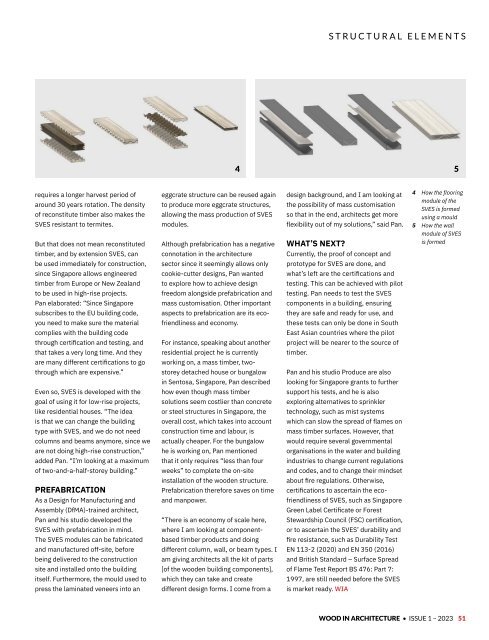Wood In Architecture Issue 1, 2023
First published in 2017, Wood in Architecture (WIA) is a bi-annual trade magazine devoted to the international timber construction sector. The newest addition to the Panels & Furniture Group of wood magazines, WIA features in-depth insights to the latest industry news, incredible projects and leading trade events. WIA is an advocate for timber as a material of choice for today’s built environment, and is the perfect source of inspiration for architects, builders, engineers and interior designers across the globe.
First published in 2017, Wood in Architecture (WIA) is a bi-annual trade magazine devoted to the international timber construction sector. The newest addition to the Panels & Furniture Group of wood magazines, WIA features in-depth insights to the latest industry news, incredible projects and leading trade events. WIA is an advocate for timber as a material of choice for today’s built environment, and is the perfect source of inspiration for architects, builders, engineers and interior designers across the globe.
- No tags were found...
You also want an ePaper? Increase the reach of your titles
YUMPU automatically turns print PDFs into web optimized ePapers that Google loves.
STRUCTURAL ELEMENTS<br />
4 5<br />
requires a longer harvest period of<br />
around 30 years rotation. The density<br />
of reconstitute timber also makes the<br />
SVES resistant to termites.<br />
But that does not mean reconstituted<br />
timber, and by extension SVES, can<br />
be used immediately for construction,<br />
since Singapore allows engineered<br />
timber from Europe or New Zealand<br />
to be used in high-rise projects.<br />
Pan elaborated: “Since Singapore<br />
subscribes to the EU building code,<br />
you need to make sure the material<br />
complies with the building code<br />
through certification and testing, and<br />
that takes a very long time. And they<br />
are many different certifications to go<br />
through which are expensive.”<br />
Even so, SVES is developed with the<br />
goal of using it for low-rise projects,<br />
like residential houses. “The idea<br />
is that we can change the building<br />
type with SVES, and we do not need<br />
columns and beams anymore, since we<br />
are not doing high-rise construction,”<br />
added Pan. “I’m looking at a maximum<br />
of two-and-a-half-storey building.”<br />
PREFABRICATION<br />
As a Design for Manufacturing and<br />
Assembly (DfMA)-trained architect,<br />
Pan and his studio developed the<br />
SVES with prefabrication in mind.<br />
The SVES modules can be fabricated<br />
and manufactured off-site, before<br />
being delivered to the construction<br />
site and installed onto the building<br />
itself. Furthermore, the mould used to<br />
press the laminated veneers into an<br />
eggcrate structure can be reused again<br />
to produce more eggcrate structures,<br />
allowing the mass production of SVES<br />
modules.<br />
Although prefabrication has a negative<br />
connotation in the architecture<br />
sector since it seemingly allows only<br />
cookie-cutter designs, Pan wanted<br />
to explore how to achieve design<br />
freedom alongside prefabrication and<br />
mass customisation. Other important<br />
aspects to prefabrication are its ecofriendliness<br />
and economy.<br />
For instance, speaking about another<br />
residential project he is currently<br />
working on, a mass timber, twostorey<br />
detached house or bungalow<br />
in Sentosa, Singapore, Pan described<br />
how even though mass timber<br />
solutions seem costlier than concrete<br />
or steel structures in Singapore, the<br />
overall cost, which takes into account<br />
construction time and labour, is<br />
actually cheaper. For the bungalow<br />
he is working on, Pan mentioned<br />
that it only requires “less than four<br />
weeks” to complete the on-site<br />
installation of the wooden structure.<br />
Prefabrication therefore saves on time<br />
and manpower.<br />
“There is an economy of scale here,<br />
where I am looking at componentbased<br />
timber products and doing<br />
different column, wall, or beam types. I<br />
am giving architects all the kit of parts<br />
[of the wooden building components],<br />
which they can take and create<br />
different design forms. I come from a<br />
design background, and I am looking at<br />
the possibility of mass customisation<br />
so that in the end, architects get more<br />
flexibility out of my solutions,” said Pan.<br />
WHAT’S NEXT?<br />
Currently, the proof of concept and<br />
prototype for SVES are done, and<br />
what’s left are the certifications and<br />
testing. This can be achieved with pilot<br />
testing. Pan needs to test the SVES<br />
components in a building, ensuring<br />
they are safe and ready for use, and<br />
these tests can only be done in South<br />
East Asian countries where the pilot<br />
project will be nearer to the source of<br />
timber.<br />
Pan and his studio Produce are also<br />
looking for Singapore grants to further<br />
support his tests, and he is also<br />
exploring alternatives to sprinkler<br />
technology, such as mist systems<br />
which can slow the spread of flames on<br />
mass timber surfaces. However, that<br />
would require several governmental<br />
organisations in the water and building<br />
industries to change current regulations<br />
and codes, and to change their mindset<br />
about fire regulations. Otherwise,<br />
certifications to ascertain the ecofriendliness<br />
of SVES, such as Singapore<br />
Green Label Certificate or Forest<br />
Stewardship Council (FSC) certification,<br />
or to ascertain the SVES’ durability and<br />
fire resistance, such as Durability Test<br />
EN 113-2 (2020) and EN 350 (2016)<br />
and British Standard – Surface Spread<br />
of Flame Test Report BS 476: Part 7:<br />
1997, are still needed before the SVES<br />
is market ready. WIA<br />
4 How the flooring<br />
module of the<br />
SVES is formed<br />
using a mould<br />
5 How the wall<br />
module of SVES<br />
is formed<br />
WOOD IN ARCHITECTURE • ISSUE 1 – <strong>2023</strong> 51


















